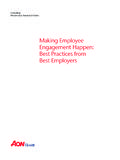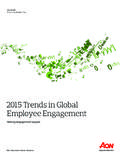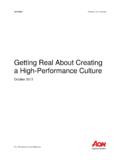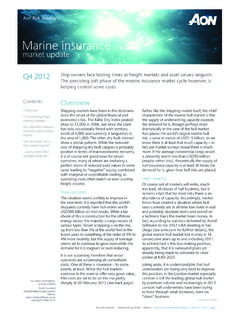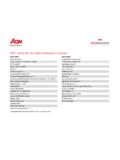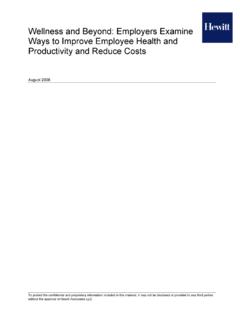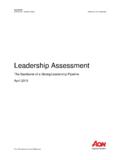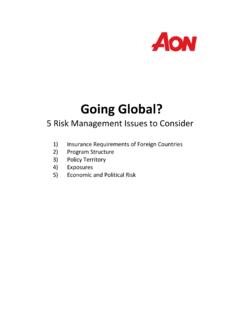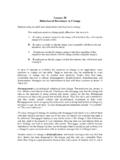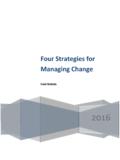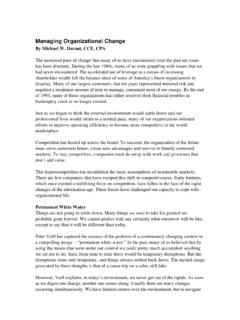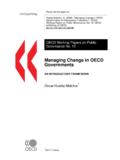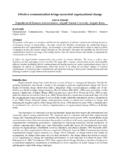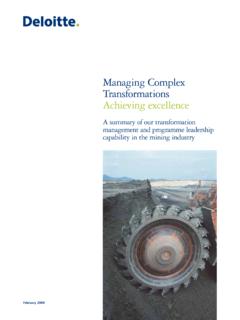Transcription of Managing Employee Engagement During Times of Change
1 Aon Hewitt Proprietary and Confidential Risk. Reinsurance. Human Resources. Managing Employee Engagement During Times of Change June 2013 Aon Hewitt Proprietary and Confidential Managing Employee Engagement During Times of Change 2 Today s global economy has clearly had a big impact on the way organizations operate. Although successful organizations are often marked by a modest, continuous level of Change , the past few years have been marked by significant business and talent survival tactics in response to challenging economic conditions. Some organizations have sought to transform their strategies ahead of, or in response to, changing economic conditions by restructuring or taking on a merger and/or acquisition (M&A). Regardless of how the Change occurs, the associated loss of status, certainty, control and familiarity that comes with this Change may be met with resistance from M&A situations in particular can cause many employees to feel confused or unsure about how they will fit in the combined Uncertainty and role conflict may lead to increased turnover, new or additional job expectations, and delays in accomplishing goals while new decision processes and budgets are developed.
2 Overall, During Times of Change it can be difficult for employees to simply keep their heads above water and stay productive. Because a large number of organizational Change efforts fail to meet their stated objectives, a focus on how employees think, feel and behave During these transformational periods offers useful insights to Maintaining Employee Engagement in the midst of organizational Change is a key element in the success of a Change initiative. In this paper, we specifically address questions about how these transformational periods are related to Employee Engagement , including: What is Employee Engagement , and why is it important? What happens to Employee Engagement During different types of Change ? What influences Engagement During Change ? What can organizations do to understand and manage Employee Engagement During Times of Change ? What Is Employee Engagement , and Why Is It Important?
3 Employee Engagement can be understood as both an emotional state and a behavioral reaction to a given work environment. As an emotional state, Engagement represents ideas such as focus, motivation and passion for the task at hand. As a behavioral reaction, Engagement goes beyond feelings and attitudes. An engaged Employee can provide significantly more discretionary effort doing whatever it takes to complete work tasks ultimately having a positive impact on business results. In short, engaged employees say good things about working at an organization, they plan to stay at that organization and they strive to give extra effort. 1 Fried, Y., Tiegs, , Naughton, , and Ashforth, (1996). Managers reactions to a corporate acquisition: A test of an integrative model. Journal of Organizational Behavior, 7, 401-427. 2 Seo, and Hill, (2005).
4 Understanding the human side of merger and acquisition: An integrative framework. The Journal of Applied Behavioral Science, 41, 422-443. 3 Ngyuen, H. and Kleiner, (2003). The effective management of mergers. Leadership and Organizational Development Journal, 24, 447-454. Aon Hewitt Proprietary and Confidential Managing Employee Engagement During Times of Change 3 Engagement is not a binary outcome rather, Engagement levels comprise a spectrum of behavior. The following table represents four broad profiles into which employees may be classified. Engagement Category Description Highly Engaged Employees feel a strong personal alignment to the mission, vision and objectives of the organization. With this emotional connection comes behavior namely, active pursuit of opportunities to improve operations and/or the general work environment. Moderately Engaged Employees possess positive attitudes toward work and may engage in productive behaviors, but they are not fully invested in terms of commitment and significant discretionary behavior.
5 Passive Employees simply come to work and go through the motions without any particular interest in work. While not as problematic as the actively disengaged, passive employees do not create a positive environment for innovation and progress. Actively Disengaged Employees feel disconnected from their jobs and tend to be unsatisfied at work. Their poor attitudes and emotions spread through the company, which can result in their own poor performance and poor performance of others. What Happens to Employee Engagement During Different Types of Change ? The last few years have been marked by significant organizational changes in response to increasingly complex and interrelated economic, regulatory, business and demographic trends. To examine the questions posed in this paper, we analyzed a large sample of Employee survey data collected by Aon Hewitt During the 2009 2010 period in the depth of the economic An analysis of these data reveals, as one might expect, that Engagement is influenced by organizational Change , including M&A, strategy transformation and restructuring.
6 Specifically, the chart on the following page highlights a great deal of what happens During Times of Change to employees at the two ends of the Engagement spectrum ( , the highly engaged and the actively disengaged). The proportion of highly engaged employees does not Change from the baseline due either to strategy transformation or restructuring. This may indicate that the most engaged employees remain resilient During these types of Change . However, the percentage of actively disengaged employees increases substantially During these Times . 4 Aon Hewitt Engagement Study 2010. Aon Hewitt Proprietary and Confidential Managing Employee Engagement During Times of Change 4 Impact of Different Types of Corporate Change on Employee Engagement The most revealing data, however, can be found During M&A activity.
7 Within the group of employees going through M&A with significant impact on their job, the proportion of actively disengaged employees increases similarly to the other transformation categories, but the percentage of highly engaged employees is cut in half During an M&A event. By contrast, more employees appear to become highly engaged when their company makes an acquisition that has no impact on their job perhaps they see opportunity to expand their sphere of influence or see positive possibilities for the future without any personal threat. The data also suggest that acquiring another organization is easier on employees than being acquired. Thus, it appears it s not just the M&A activity that influences Engagement , but rather the extent to which the M&A impacts an individual s job and whether one works for the acquiring organization or for the acquired. The next question to consider is whether these M&A Engagement effects linger.
8 Can we expect the percentage of highly engaged employees in an M&A situation to remain stable over time as the organizations combine? 10% 10% 5% 7% 13% 11% 19% 19% 21% 18% 11% 16% 0%5%10%15%20%25%Restructuringwith significantimpact on jobBusiness/Strategytransformationwith significantimpact on jobAcquired withsignificant impacton jobMade acquisitionwith significantimpact on jobMade acquisitionwith NOsignificant impacton jobAcquired with NOsignificant impacton jobPercent of Employees Highly EngagedActively Disengaged13% 10% ---- Baseline ---- Baseline Aon Hewitt Proprietary and Confidential Managing Employee Engagement During Times of Change 5 The answer is no or, at least, not consistently. Individual reactions to organizational changes fluctuate at various stages of the acquisition process. Immediately after any merger or acquisition, more employees are engaged by the prospect of a new direction.
9 However, the reality of the changes that come with integration and restructuring may cause employees to begin to disengage. We see that the percentage of highly engaged employees tends to dip well below the 10% global baseline after a merger or acquisition. In fact, the percentage of highly engaged employees dips to 5% a few months after a merger or acquisition, and does not recover to the baseline for another two to three years. This drop can be quite problematic for employers seeking to increase buy-in to a new integrated business model and demonstrate the value of the merger or acquisition to stakeholders. Another way to examine the data is to think of a balance between job demands and job control. Increased job demands and decreased control soon after the merger or acquisition may increase Employee stress and After employees become accustomed to the demands and controls of the job, their Engagement levels recover over time .
10 The graph above follows and validates the Change curve often cited by Change management professionals. This finding suggests that it can take a long time for employees to recover to baseline levels after M&A events. Many organizational leaders want to know what can be done to decrease the depth of the Engagement dip and/or to accelerate the time to recovery. Regardless of the type of Change , the degree to which employees can identify with their organization, see a clear future or strive toward organizational objectives seems to be most significantly at risk During Change events. We know that it can take months or years for employees Engagement to recover. We also know that Employee Engagement , and particularly the percentage of highly engaged employees, is positively correlated to higher performance and business value creation. These findings suggest that Employee Engagement is both an opportunity and a risk to be managed During Times of transition.
